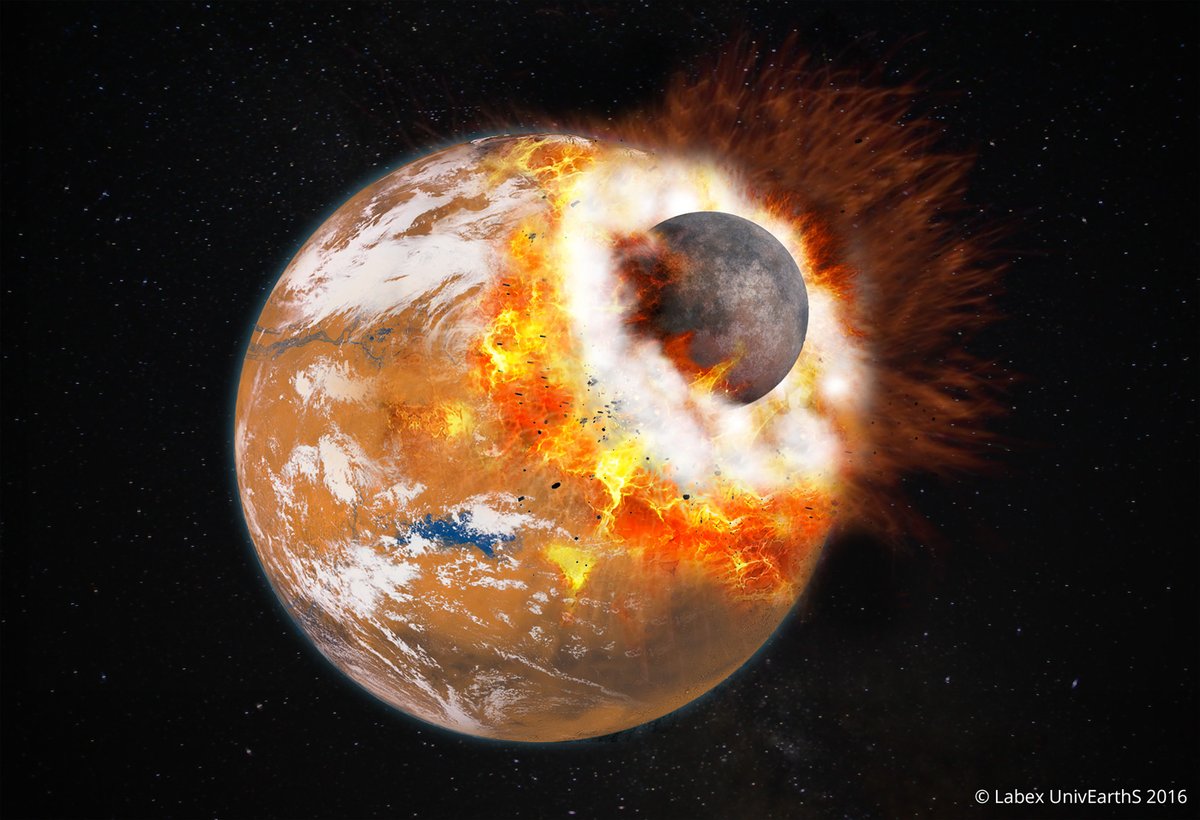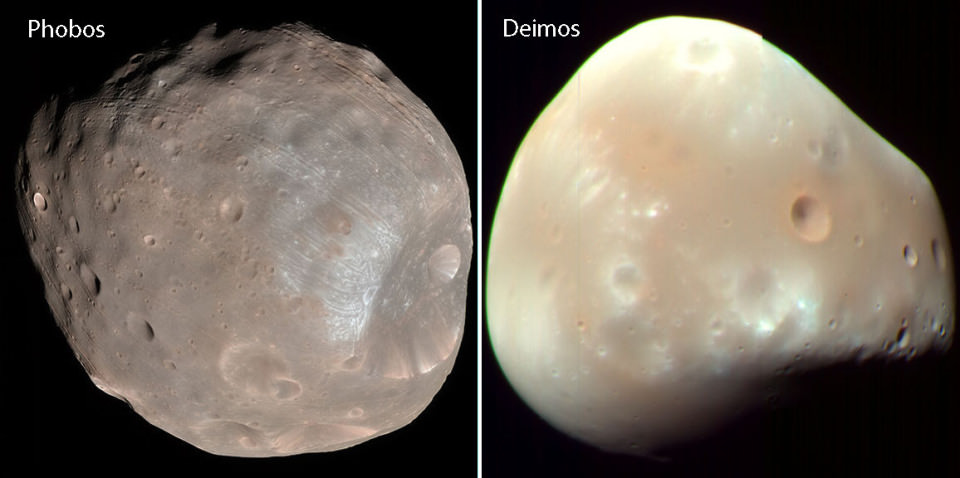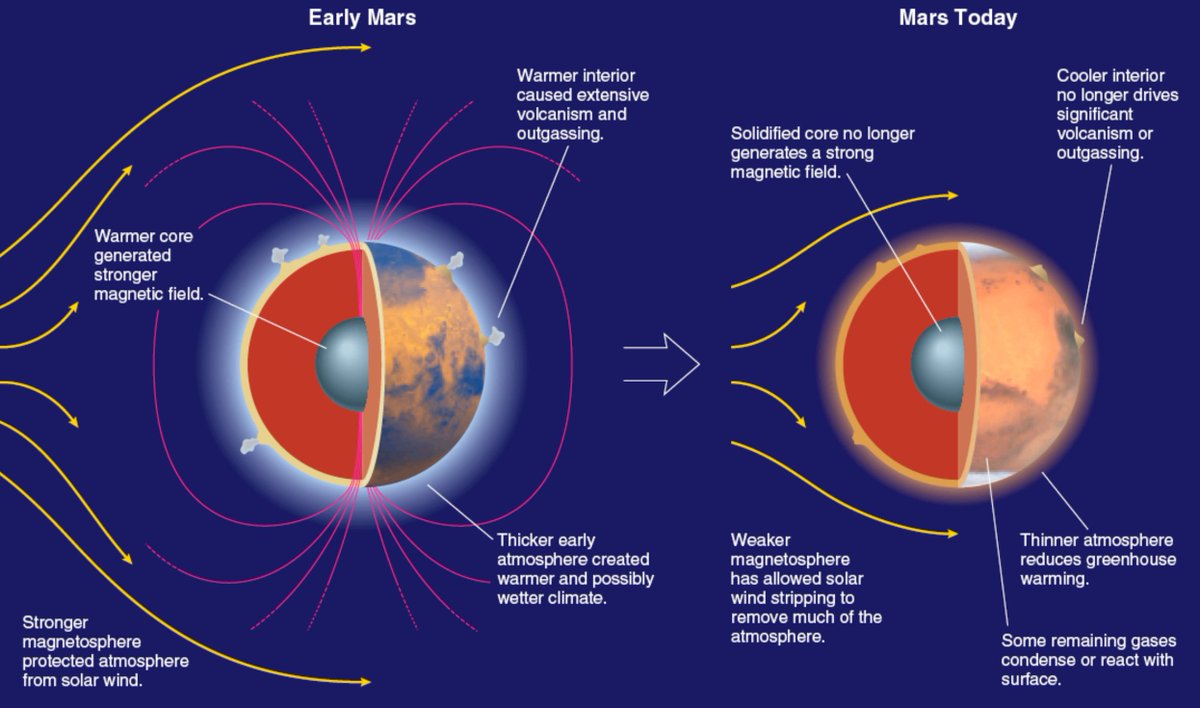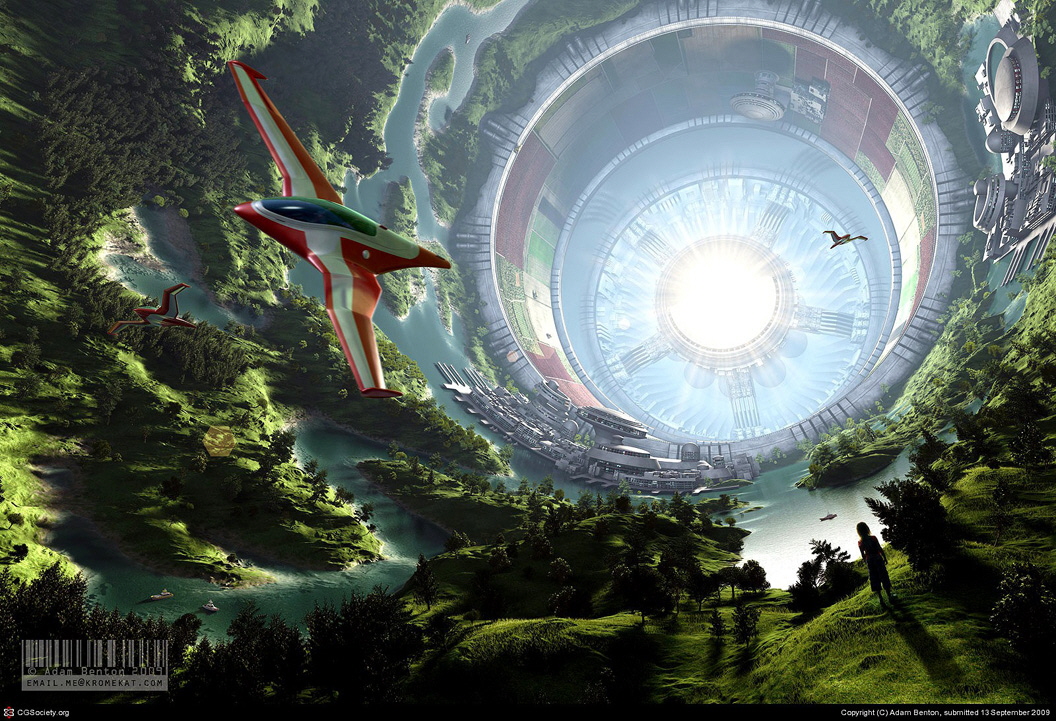So it’s time to talk about terraforming Mars. You may have heard about this in movies, but how would we really do it? I’m going to talk about what terraforming is, why and how we would terraform Mars, the issues it consists of, and my own thoughts on the subject. #scicomm (1/22)
Coined by sci-fi novelist Jack Williamson, terraforming is the process of modifying a hostile body, specifically its atmosphere, temperature, and topography in order to make habitable for life suitable to Earth. What is my definition of habitable? The planetary body must...(2/22)
...have extensive amounts of surface liquid water, allow for biological macroevolution, and be a sufficient energy source for the organisms that inhabit it. Currently, Mars is uninhabitable, and I’ll talk about the reasons why, and how terraforming could change this. (3/22)
The three things that make Mars uninhabitable and what we& #39;d have to target when terraforming is its atmosphere, (lack of) magnetosphere, and temperature. They& #39;re all intertwined with each other, but I& #39;ll talk about the aspects of each one. First up: the Martian atmosphere (4/22)
Mars& #39; thick atmosphere has over time been stripped away by solar wind that its lack of magnetosphere could not prevent. Now with its pretty thin atmosphere is only 0.6% that of Earth. Its low surface gravity (11% of Earth) also leads to the planet not being able to hold...(5/22)
...onto the atmosphere well enough, leading to its loss. The biggest step in terraforming would be to recreate the thick atmosphere. One way of increasing density is to bombard Mars with greenhouse gas rich asteroids in order to supply Mars with the necessary volatiles. (6/22)
We could also possibly increase CO2 content by doing a lot of warming, which leads to my next topic: temperature. On Mars, the average surface temperature is well below freezing, so we would need to warm things up to make the atmosphere warm the planet up. (7/22)
Heating Mars up will hopefully lead to the CO2 in the atmosphere to trap the heat, leading to a greenhouse effect. This can also lead to the ice in the polar caps to heat up, which leads to the CO2 reservoirs evaporating and contributing to the atmosphere. One way of… (8/22)
...heating would be to lower Mars& #39; albedo, aka planet reflectivity, so more solar radiation is absorbed. We could possibly take dust from Mars& #39; moons, Phobos and Deimos, and spread it over the planet since the moons reflect such little light. Another way of heating... (9/22)
...could be the creation of very large orbital mirrors that could reflect incoming solar radiation and direct it towards the planet& #39;s surface. One last way is to have photosynthetic organisms such as plants and algae help contribute to warming the planet. This is all... (10/22)
...great, but all these efforts are pointless if our atmosphere is going to just get stripped away due to the lack of magnetic field. It is believed that Mars lost its magnetic field due to its core solidifying during planet formation. A way of creating a magnetic field...(11/22)
...could possibly be to make enormous superconducting magnetic rings that can direct current, along with a couple of other methods.
Okay, we& #39;ve got the basics of terraforming down, now let& #39;s discuss the three issues that come with it. (12/22)
Okay, we& #39;ve got the basics of terraforming down, now let& #39;s discuss the three issues that come with it. (12/22)
First off, ethics. We’re debating whether sustaining our own human lives is important enough to completely morph (and basically destroy) another planet. Should we be playing God? We would also be erasing Mars& #39; entire history. Is this all worth it in the end? (13/22)
Also, our own planet earth is constantly heating up and dying. Does humankind have the capacity to treat another planetary body with enough respect to prevent a global disaster, aka climate change, from happening again? Because right now it doesn’t seem so. (14/22)
Next, economics. Terraforming will cost a lot of money, and no current models take into account the actual economic feasibility of doing it. Will government agencies or private companies have enough money to make this happen feasibly? Even if we were to combine numerous...(15/22)
...sources of funding, does it even make sense to direct that money towards the long process of terraforming, or towards our own planet and smaller innovative ideas? There are many economic crises on Earth that need immediate attention, and terraforming isn& #39;t one of them. (16/22)
Lastly, methodology. Terraforming Mars would possibly consist of depleting Earth of its own resources. Also, just using natural Mars resources would only increase the atmospheric pressure a tiny bit. Will we ever have the infrastructure needed for this effort? Honestly... (17/22)
...probably not. There is so much technology that would need to be developed, like asteroid redirecting, fusion plants, effective mineral transport systems, and hundreds more in order to consider the possibility, and all of this just for one planet. (18/22)
Now for my own thoughts. Do I think we should terraform Mars or just terraform planets in general? Imma say no. I look back at our own planet which is slowly dying due to our own human behavior, and scientists are still fighting the fight on whether... (19/22)
...climate change is actually real. We have yet to fix the important and complicated issues of Earth, and people are considering colonizing a planet and making it suitable for their own lives when we have yet made Earth suitable for all humankind. I do though understand...(20/22)
...the need for wanting to sustain the human race. But terraforming shouldn& #39;t be the way to do this, and I instead believe in the creation of O& #39;Neill cylinders (this is what my next thread will be on!). But yeah, for now, it& #39;s going to be a no from me. ¯\_(ツ)_/¯ (21/22)
So there’s my thread on terraforming! I hope you all enjoyed and continue to learn more about the subject on your own. Please let me know if I need to correct anything! Expect the next thread on O& #39;Neill Cylinders to come out sometime next week  https://abs.twimg.com/emoji/v2/... draggable="false" alt="😎" title="Lächelndes Gesicht mit Sonnenbrille" aria-label="Emoji: Lächelndes Gesicht mit Sonnenbrille"> (22/22)
https://abs.twimg.com/emoji/v2/... draggable="false" alt="😎" title="Lächelndes Gesicht mit Sonnenbrille" aria-label="Emoji: Lächelndes Gesicht mit Sonnenbrille"> (22/22)

 Read on Twitter
Read on Twitter






 (22/22)" title="So there’s my thread on terraforming! I hope you all enjoyed and continue to learn more about the subject on your own. Please let me know if I need to correct anything! Expect the next thread on O& #39;Neill Cylinders to come out sometime next week https://abs.twimg.com/emoji/v2/... draggable="false" alt="😎" title="Lächelndes Gesicht mit Sonnenbrille" aria-label="Emoji: Lächelndes Gesicht mit Sonnenbrille"> (22/22)" class="img-responsive" style="max-width:100%;"/>
(22/22)" title="So there’s my thread on terraforming! I hope you all enjoyed and continue to learn more about the subject on your own. Please let me know if I need to correct anything! Expect the next thread on O& #39;Neill Cylinders to come out sometime next week https://abs.twimg.com/emoji/v2/... draggable="false" alt="😎" title="Lächelndes Gesicht mit Sonnenbrille" aria-label="Emoji: Lächelndes Gesicht mit Sonnenbrille"> (22/22)" class="img-responsive" style="max-width:100%;"/>


